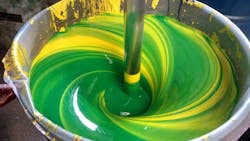Troubleshooting Challenge: Ink Mixing Machine’s rpms Fluctuate Out of Limits
An ink manufacturer had a large ink mixing machine with a problem of slowing down and speeding up. When it dumped several 100-lb bags of two different chemicals into the mixer while the blades were turning, their rotation would drop below the rpms called for in the recipe. The operator would go to the control panel and turn the speed control pot up until the speed met the recipe’s requirements. He would then add water and liquid dye which made the rpm’s increase beyond the required speed. So, the operator had to turn down the speed.
The operator was making several adjustments, both up and down, until the rpm’s stabilized. After an hour or two of proper mixing, he would pump the mixture into large containers and start processing another batch.
The mixer blades were driven by a hydrostatic closed loop system. They had been upgraded recently with a servo valve amplifier circuit. So, the manager asked the installer to check the signal to the valve to see if it was varying when the speed changed. The installer reported that the signal did not vary when the speed varied.
The operator claimed it ran fine until the new controls were installed. The old and the new control did not have feedback signals. He did notice the hydraulic charge pressure would drop from 300 psi to about 200 psi only when the speed would drop but recovered when the unit oversped.
What’s the Problem?
Think you know the answer to this month’s troubleshooting problem? Then email your answer to [email protected] (put “Feb Troubleshooting” in the Subject line.) All correct answers received by Feb. 20, 2020 will be entered in a random drawing. The winner will be mentioned in a future column.
Richard Throop correctly answered the problem posed in the January issue. Congratulations!
Solution to last month
Repeated O-Ring Failures on a Cross-Port Relief
Relief valves used as cross-port reliefs require a back-up support on both sides of the O-ring that seals incoming pressure from the outlet. When there is pressure on the outlet and little pressure on the inlet, the O-ring needs to seal in the opposite direction, so it needs a back-up on both sides. The problem could be exacerbated by the pressure-compensated flow control between the relief outlet and motor creating additional pressure.
Robert J. Sheaf Jr., is founder and president of CFC Industrial Training, a Div. of CFC Solar, which provides technical training, consulting, and field services to any industry using fluid power technology. Visit www.cfc-solar.com for more information.
About the Author
Robert Sheaf
President
Robert J. Sheaf Jr., is the founder and president of CFC Industrial Training, formerly Certified Fluid Consultants, part of CFC-Solar Inc. CFC-Solar provides technical training, consulting, and field services to any industry using fluid power technology.

Leaders relevant to this article:
